What is the most authentic Spanish paella recipe? It's a controversial subject! But this classic paella valenciana recipe is the traditional chicken paella that many call the original. It combines chicken and either pork ribs or rabbit (your choice!) with green beans, butter beans, garlic, paprika, and saffron.
If you love paella, you'll definitely want to try my recipes for seafood paella, black paella, vegetable paella, and prawn and chorizo paella (my mother-in-law's favorite).
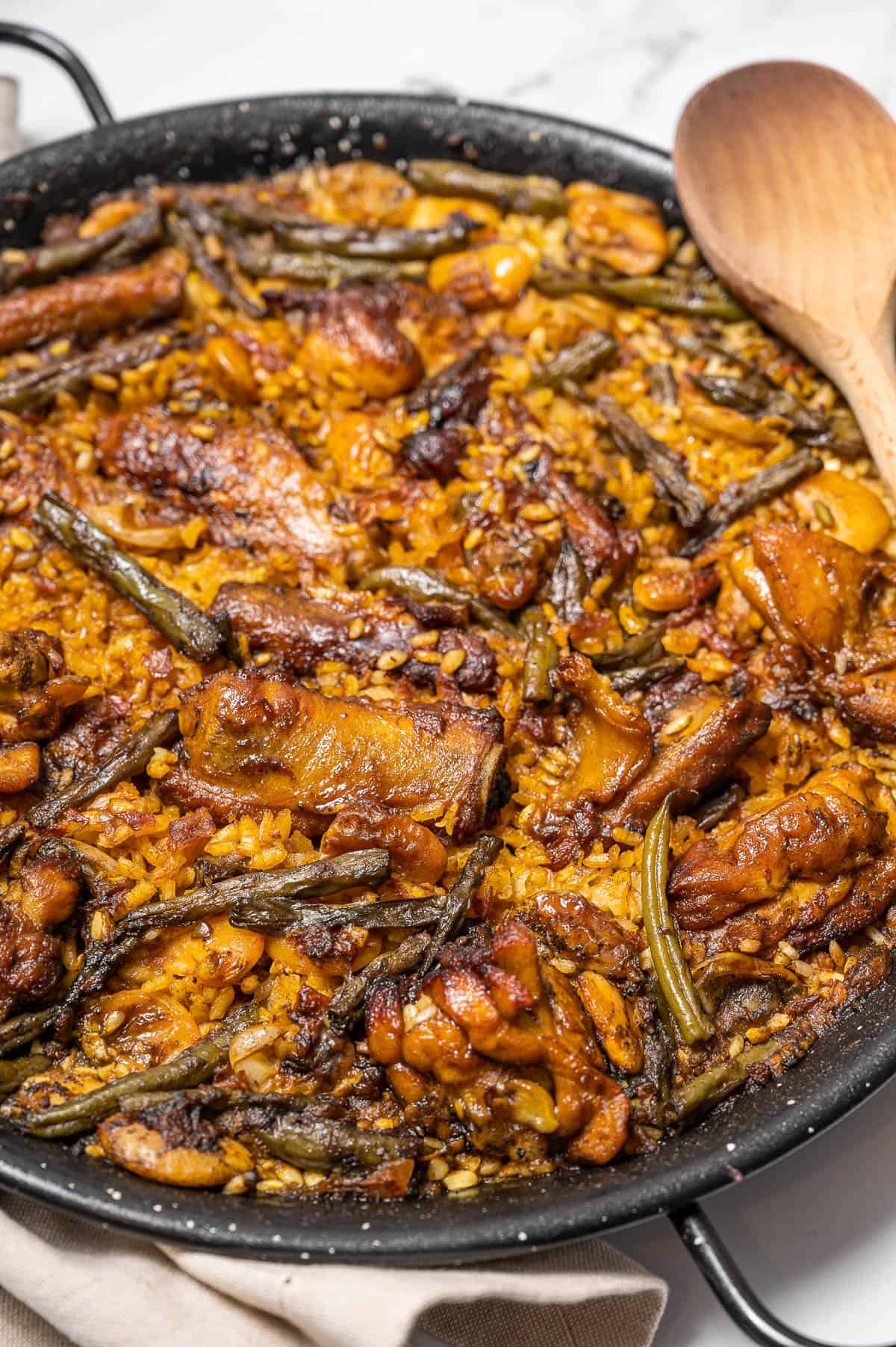
Jump to:
Introduction
Unfortunately, most paellas served across Spain are bad copies of the real thing. Their artifical neon yellow color comes from food coloring rather than saffron, and the rice is piled high to conceal the overcooked shrimp mixed in.
How can you get a taste of authentic paella? Make a traditional paella at home! A little time and love make paella valenciana one of the most delicious Spanish rice dishes. If you're looking for the classic Spanish paella recipe, you're in the right place.
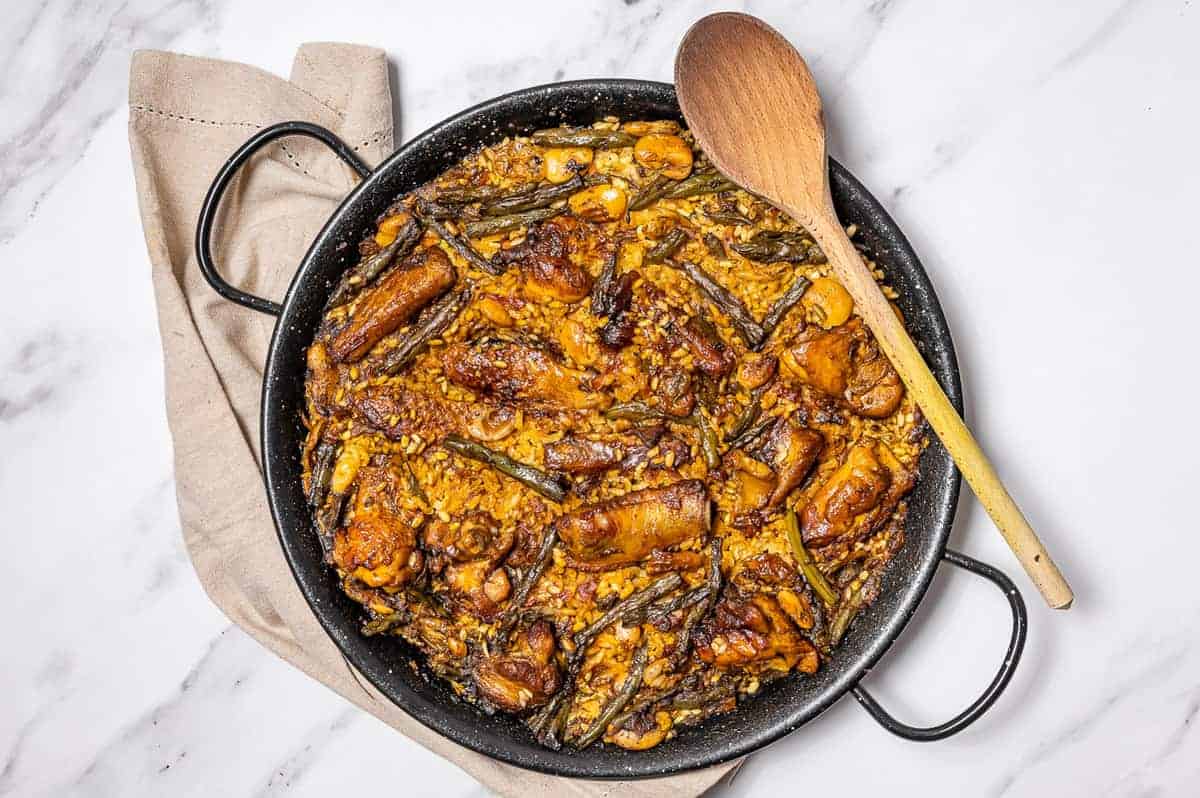
What Is Paella?
Most visitors to Spain think that paella is a mix of seafood and meat. While this version does exist, there are many regional variations of paella, and they feature only a few key ingredients, as the rice itself is supposed to be the star of the show. You can read more about the history of paella if you're curious.
Contrary to popular belief, the traditional version of paella from Valencia doesn't contain seafood! While the most well-known versions of the dish include shrimp and mussels, traditional paella valenciana is made with chicken and rabbit (and often snails), and is spiced with sweet paprika and a few strands of golden saffron.
A mark of a good paella is the socarrat. The slow, undisturbed simmering of the rice in broth means that the bottom layer will start to caramelize, and it’s this crispy base of rice that makes paella a taste sensation! Keep reading for tips on how to get socarrat.
Ingredients
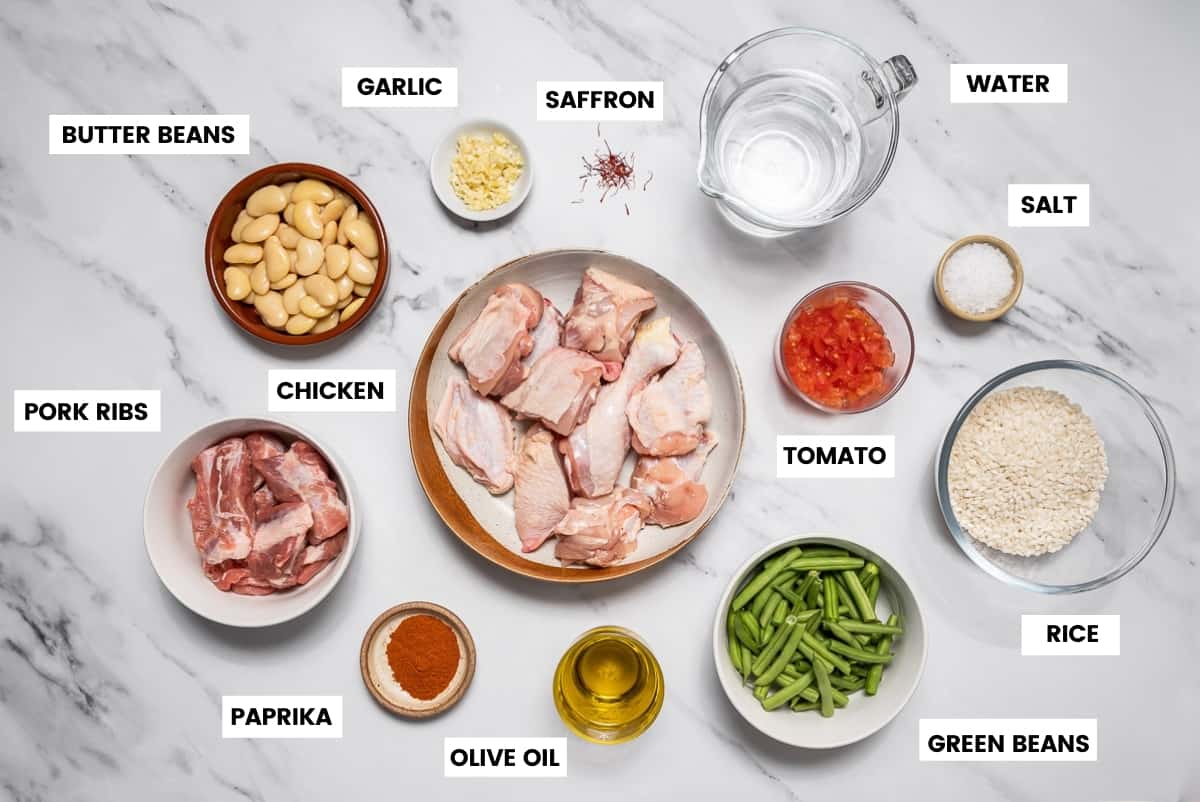
Curious what you need to make an authentic paella valenciana? Let's talk about the most important ingredients in this Spanish dish.
- Rice: It's best to use a short to medium grain, round rice, such as Bomba, Calasparra, or Senia. These rice varieties absorb three times as much liquid as regular rice without becoming mushy. So try to find it or order it in advance!
- Meat: The four most common proteins in paella valenciana are chicken, pork, rabbit, and snails. Feel free to experiment with a mixture of these based on your preferences/availability. (I prefer to use a mixture of chicken and pork ribs.) Have your butcher chop the chicken into small pieces, as this will allow caramelization to occur in the paella, improving the flavor.
- Water: Valencians swear that the local water makes their paella better, but since I live in Madrid, I don't know if that's true. Regardless, make sure that you never add stock; use only water. The exact amount you'll need can be tricky to determine, but I'll share my tips to help you!
- Olive Oil: This recipe requires a lot of oil. The excess oil in the sofrito is what helps form the all-important socarrat (that crispy bottom layer of the paella).
- Spices: Use Spanish paprika (pimentón) if possible. I like pimentón de Murcia, which isn't as smoky as pimentón de la Vera, but both work well. If you can get some, I'd also recommend using saffron in this dish for authentic color and flavor, but you can omit it if needed.
See recipe card for full information on ingredients and quantities.
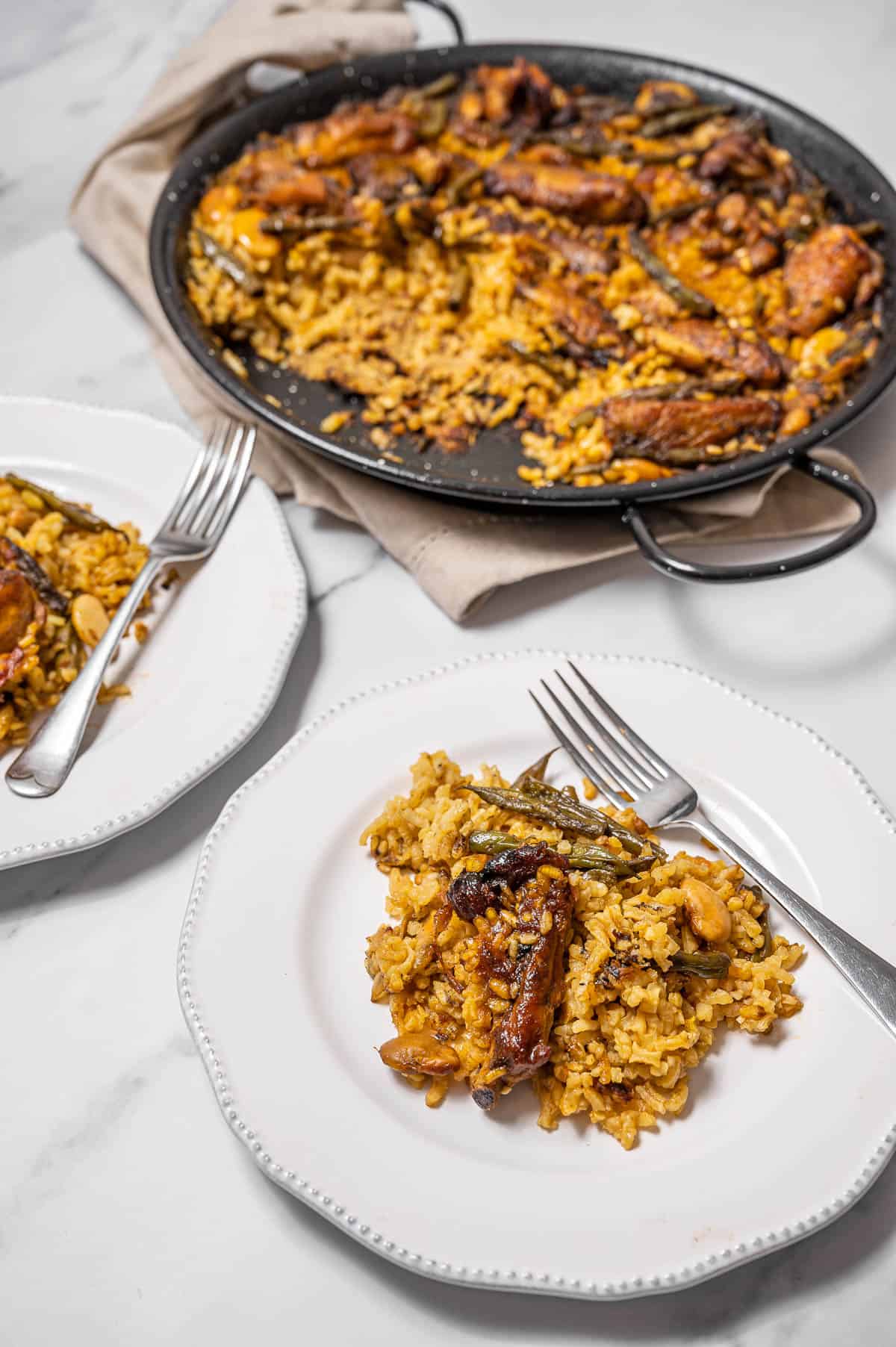
Variations
- Meat: If you prefer to use 100% rabbit meat instead of chicken, or a mix of rabbit and snails, go for it! Rabbit, snails, chicken, and pork are the four most common proteins found in paella valenciana.
- Garlic: Garlic is only used by 48% of chefs, as some argue that it has no place in a traditional paella. I happen to love the flavor it adds, but feel free to omit.
- Tomato: Tomato deglazes the pan to increase flavor, and helps make the sofrito. Traditionally, freshly grated tomato is used, but you can substitute with passata or good quality canned crushed tomatoes.
- Green Beans: In Valencia, they use a flat green bean called judía ferradura. If you can't find these, use good quality fresh string beans or frozen ones if you're in a pinch.
- Butter Beans: In Valencia, the local variety of Lima bean is called garrofó. Be sure to pre-cook dried beans before adding to the paella, or use a good quality canned variety.
- Rice: If you can’t find Spanish rice varieties where you live, you can use Arborio, although the results will be different.
- Saffron: Traditional Spanish paella recipe needs saffron; the color and subtle flavor this expensive spice provides are unique. If you don't have any on hand, add a pinch of turmeric for color if desired.
- Salt: This recipe calls for a good amount of salt, but it will amplify the flavors in the dish and make the most delicious paella you've ever tried!
How to Make
If you’d like to see the full ingredients and instructions, scroll to the bottom of the post for the printable recipe card.
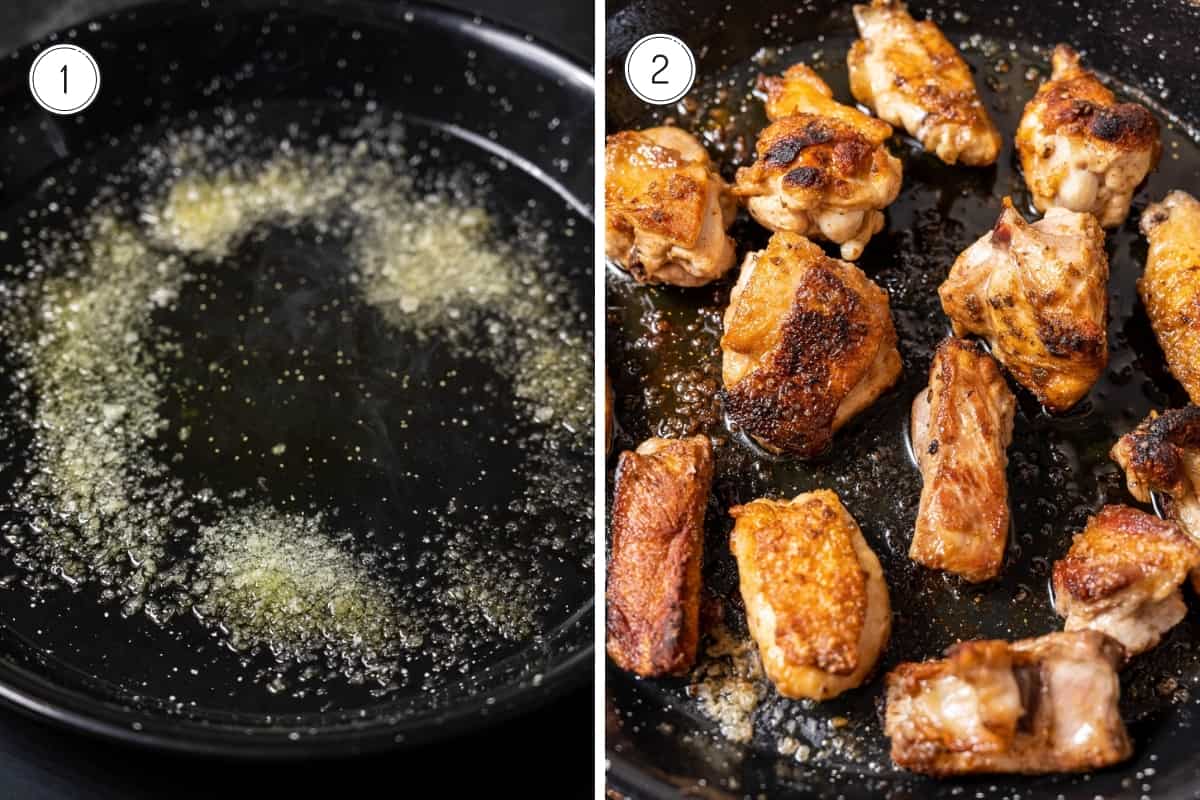
- Place a paella (large pan for making paella) or a large skillet on medium-high heat and add the olive oil. Sprinkle all the salt in a circle towards the edge of the pan to keep the oil from splattering excessively, then add all of the meat (the chicken and either rabbit or pork ribs).
- Brown the meat on all sides over the next 20 minutes, turning it every 3-5 minutes. All of the bits that stick to the pan here will come off when you add the tomato and water in the future, and they'll really bring a deep flavor to the cooking liquid.
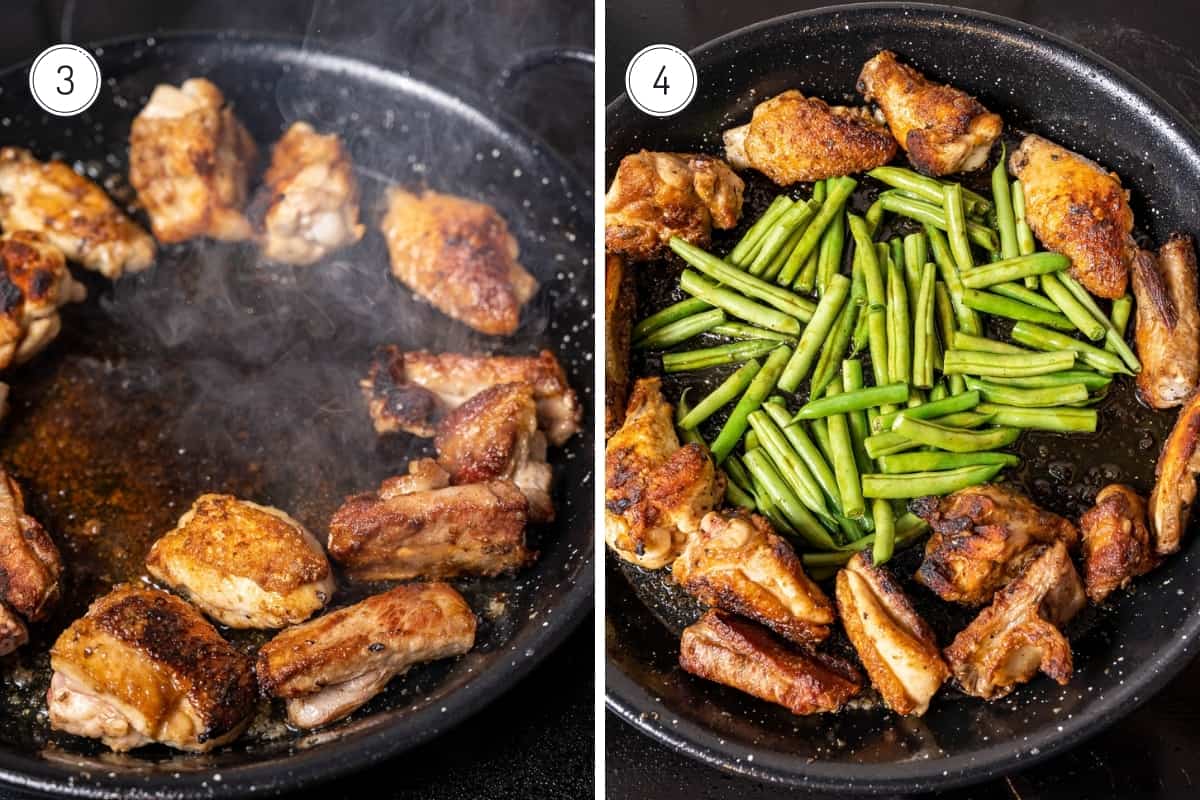
3. Push the browned meat to the edges of the pan, and allow the olive oil to pool in the center.
4. Add the green beans and sauté for about 3 minutes.
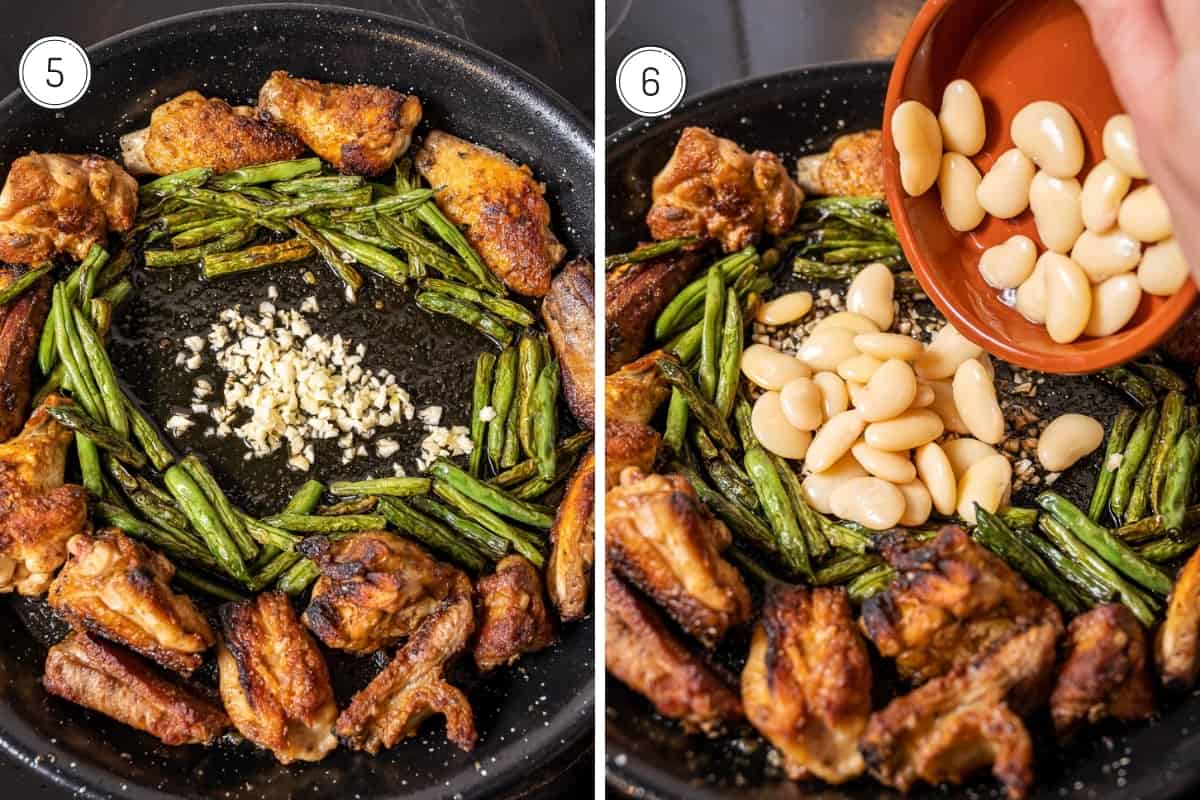
5. Push the beans to the edges and add the garlic. Sauté for about 30 seconds, or until fragrant.
6. Add the butter beans. (If you're using jarred butter beans, be careful not to break them.) Gently toss the beans in the oil and garlic, then let them brown for about 30 seconds per side.
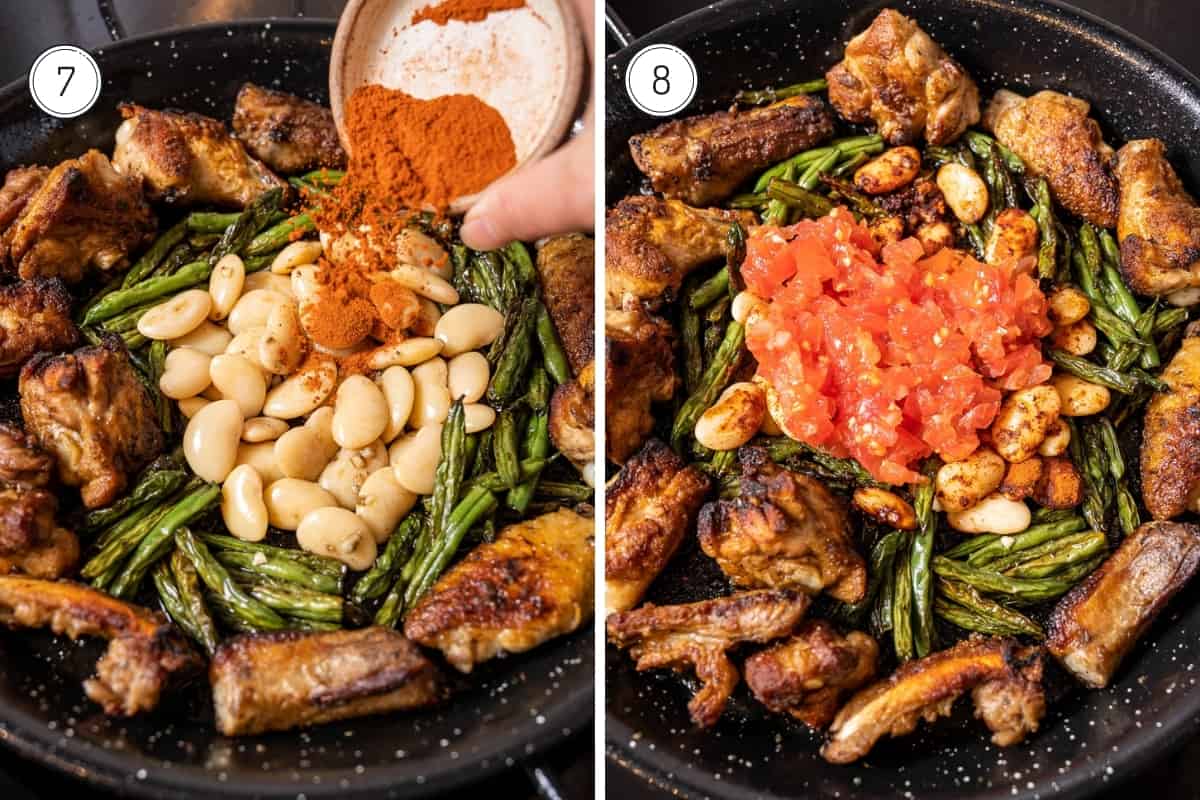
7. Add the paprika and gently sauté for about 1 minute.
8. Add the crushed tomatoes and stir everything together. The tomato should start to deglaze the pan (loosen all of the stuck bits below). Use a wooden spoon to scrape off all these flavorful bits and incorporate them into the dish.
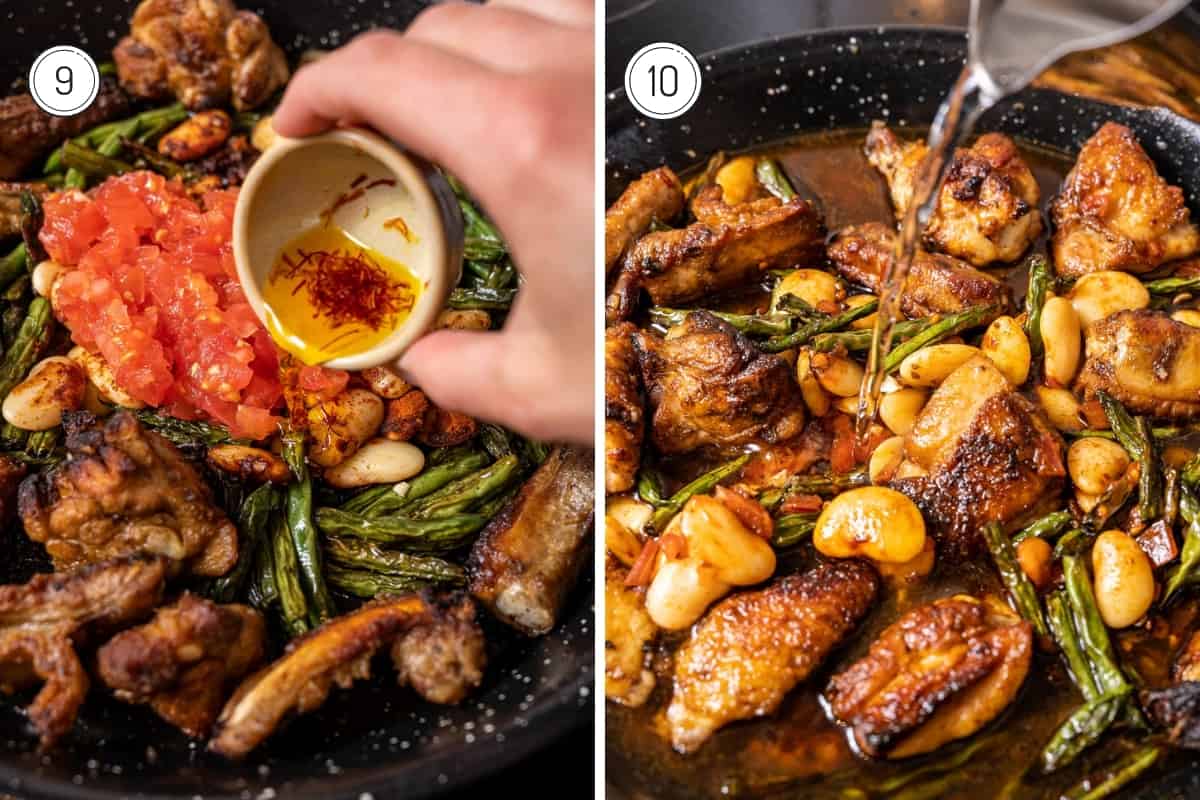
9. Add the saffron. Make sure to infuse this in a couple tablespoons (30-45 ml) of boiling water for at least 10 minutes prior to adding.
10. Pour in 5 cups of water. You'll add the remaining 4 cups in a moment.
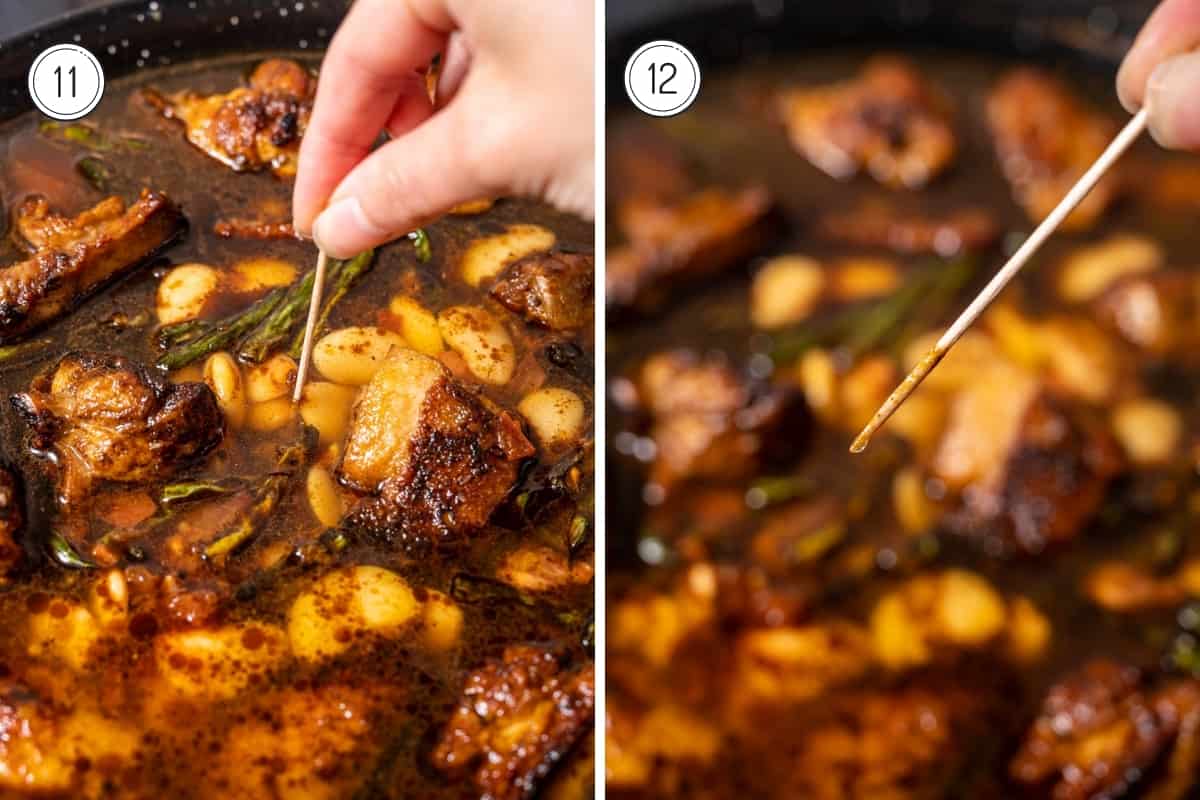
11. Insert a toothpick (or wooden spoon handle) into the center of the pan. See the water mark on the toothpick? This is the perfect amount of liquid you'll need to cook the rice.
12. Save this toothpick for later, as you'll need to check the liquid level in the pan.
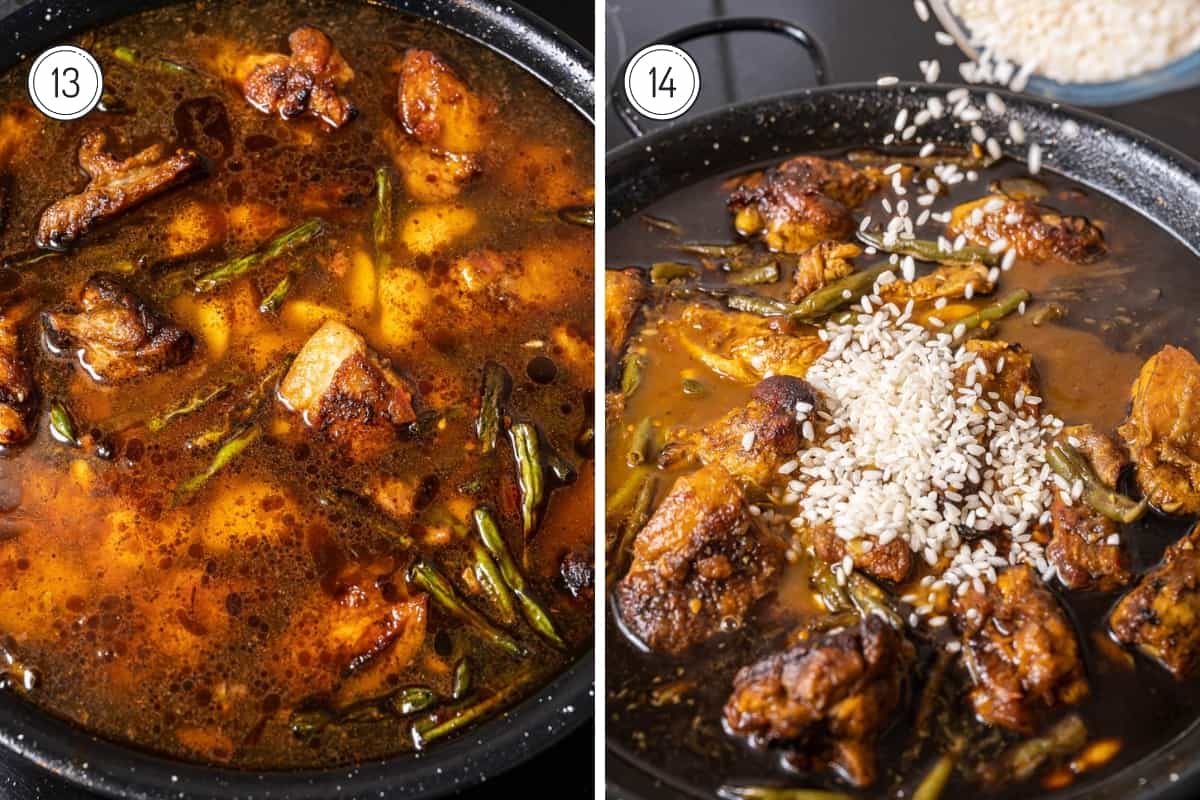
13. Add the other 4 cups (960 ml) of water. Boil for about 10 minutes, and then simmer for 15-20 minutes. There should be 5 cups of water left in the pan (the amount needed to make rice for 4 people). Check by using your toothpick; the water line should match the same mark as before. If it's higher, keep cooking; if it's lower, add a bit more water.
14. Add the rice, making sure it's covered by broth and more or less evenly distributed. Don't stir after incorporating the rice, no matter how tempted you are! This is key to making sure the rice cooks properly and doesn't release tons of starch.
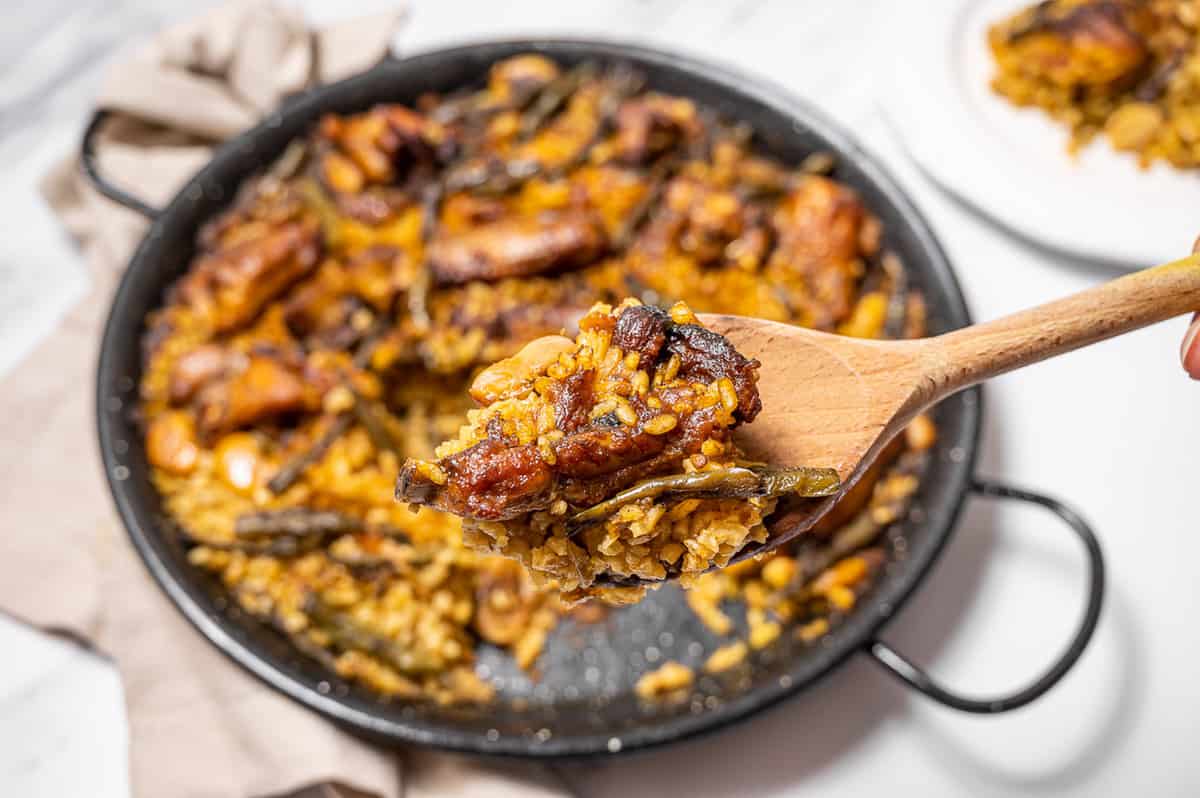
15. Cook the rice on medium-high for the first 10 minutes, then turn the heat down to medium-low and cook until all the liquid is absorbed, about 8-10 minutes. The exact cook time depends on the variety of rice (for reference, Bomba rice takes 20 minutes in total).
16. Another sign the paella is done is a faint crackling sound from the pan, which means the crispy rice, or socarrat, is forming. Once you hear this, turn the heat up for about 30 seconds, but make sure to stop and turn off the heat if you smell burning!
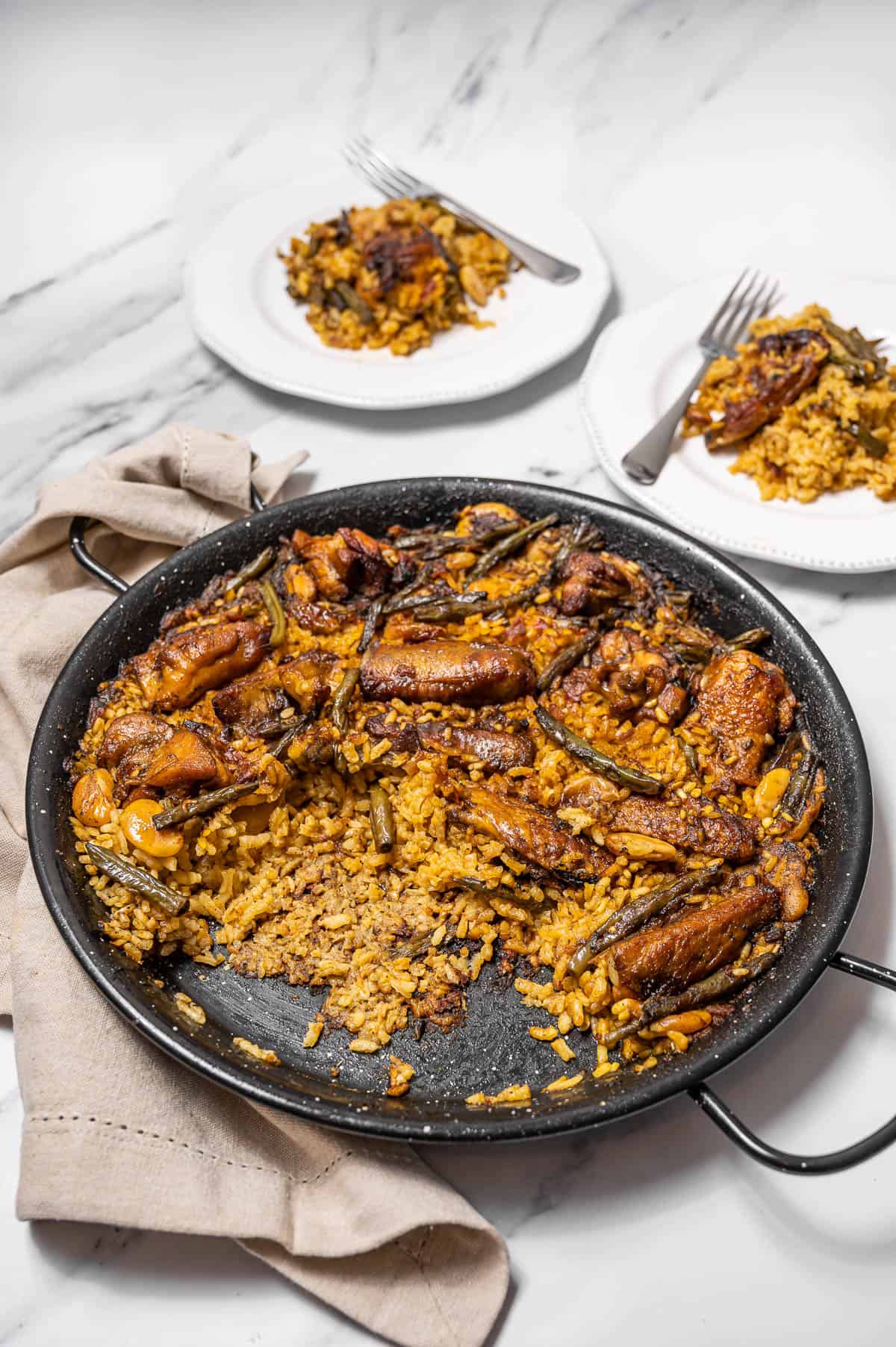
17. Take it off the heat and cover it with a dishtowel or newspapers, then let it rest for 5 minutes. Serve the paella family-style--directly out of the pan using a wooden spoon. If you prefer to use plates, just make sure to scrape the bottom of the pan and give everyone some socarrat!
Recipe FAQs
Traditional Valencian paella consists mostly of short-grain rice, which the star of the dish, and a generous amount of protein, which can come from chicken, pork, rabbit, or snails. This version of paella also traditionally includes a simple sofrito, flat green beans, and butter beans (garrafón). These ingredients are simmered in a paprika and saffron-infused broth for an amazing flavor.
There are hundreds of different rice dishes in Spain, and many are called paella. Seafood paella is very popular, but many Valencians would argue that the dish called "paella" can only be traditional paella valenciana. This version of paella contains chicken and traditionally rabbit.
A short-grain, round rice is best for paella; also a variety preferably grown in Spain. My favorite type is Senia, but it can be hard to find, so other varieties like Bomba or Calasparra are excellent choices. In a pinch, you can substitute with Arborio rice, but this will yield a different result.
The word paella means "frying pan," which is also the name for the distinctive shallow pan traditionally used for cooking this rice dish. It can be confusing because the dish (paella) is named after the vessel it's cooked in (also a paella).
Serve
Paella Valenciana makes the perfect weekend lunch meal. Like the hamburgers at a barbecue, it's the main event! But while waiting for it to cook, start with some tapas, like gazpacho shooters, ham croquettes, or boiled shrimp.
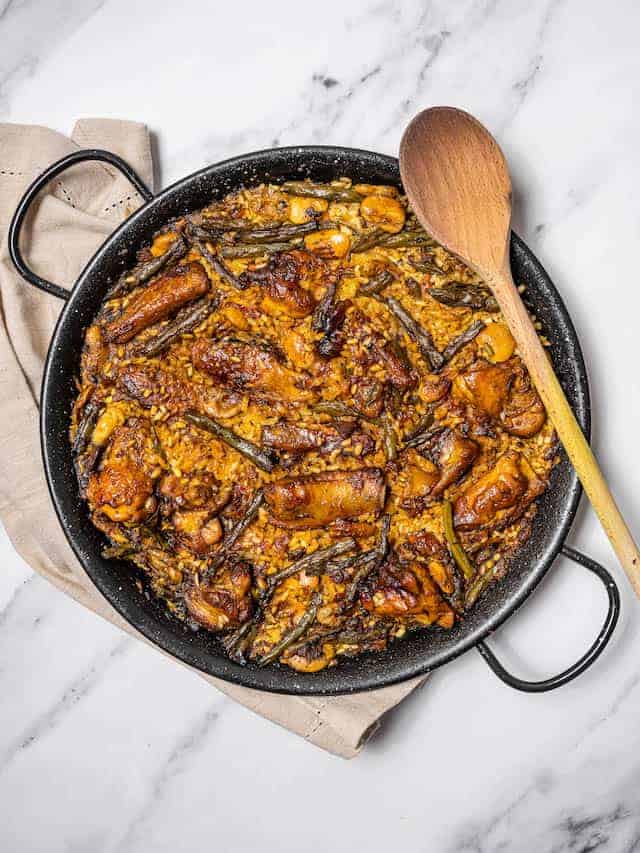
Store
Make Ahead: Both the sofrito and stock can be made in advance. You can make the entire dish up to the point of adding the rice, then let it cool and refrigerate for up to 2 days or freeze for up to 3 months.
When you are ready to prepare the paella, bring the mixture to a rapid simmer and make sure any liquid that evaporates is added back (so you have a 3:1 rice/water ratio). Then add the rice and continue with the recipe as written.
Leftovers: Store any leftover paella in the fridge in an airtight container for 1-2 days.
Reheating: Heat up leftover paella on the stove or in the microwave. let it warm up for about 30 minutes before reheating, then put some olive oil in a frying pan and gently stir the paella until it's heated through.
Freezing: It's not recommended to freeze paella. Try to make a smaller batch that you can eat within 2-3 days.
Expert Tips
- The ideal paella rice is a short/medium grain round variety such as Bomba rice. If necessary, you can substitute Arborio. Order it in advance if you can!
- Want to cook this in a paella (a special shallow pan)? I recommend using a 22-inch (56 cm) paella for this recipe. If possible, cook over an open flame, like a gas stove, or with an outdoor paella kit.
- Don't have a paella? Use a large skillet, such as cast iron. Don't use a small pan, or you'll have a hard time achieving socarrat.
- If you can’t find saffron or it is cost-prohibitive, you can use a pinch of turmeric for color or simply omit it.
- Hard rice? This means it's not cooked enough. Perhaps you evaporated the liquid too quickly, or didn't have quite enough to start with. Fix it by covering the cooked paella with a dishtowel or newspapers for 5-10 minutes to steam the rice as it rests.
- Mushy rice? This means the rice was overcooked, and unfortunately, there's no quick fix for this. Be sure you have the right rice-to-water ratio for the variety you're using.
More Paella Recipes
If you liked this recipe, please share it with others!
Follow Spanish Sabores on Facebook, Pinterest, and Instagram for more recipes and travel tips.
If you've made and enjoyed this recipe, please leave a 5-star review!
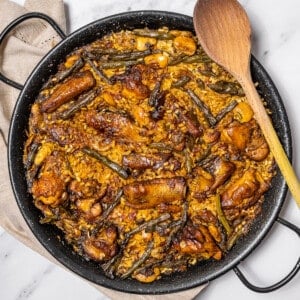
Spanish Paella Recipe (Paella Valenciana)
Ingredients
- ⅓ cup virgin or extra virgin olive oil preferably Spanish
- ½ whole chicken chopped into about 15 pieces
- 1 lb pork ribs chopped into small pieces
- 4 garlic cloves minced
- ⅓ cup fresh tomatoes grated (about 2 tomatoes)
- 10 ounces flat green beans cut into 2-inch pieces
- ⅓ lb butter beans (or garrafón) fresh or canned
- 2 teaspoons sweet Spanish paprika preferably unsmoked
- 1 pinch saffron about 10 threads
- 14.1 oz Spanish short-grain round rice such as Senia, Bomba, or Calasparra
- 1.5 tablespoon salt
- 9 cups water
- ½ whole rabbit (optional) cut into small pieces (omit ribs if using)
Instructions
- Heat a 22-inch paella (large shallow pan) or a large skillet over medium-high heat and add the olive oil. Sprinkle the salt in a circle around the edge of the pan to minimize splattering.
- Add the chicken and pork ribs or rabbit (if using) and cook until golden brown, about 20 minutes. Turn the meat every 5 minutes. The browned, caramelized bits that stick to the pan will give lots of flavor to the paella.
- Push the meat away from the center of the pan, then add the green beans and cook for about 3 minutes.
- Move the beans to the edge and add the garlic. Sauté for about 30 seconds, making sure not to burn.
- Add the butter beans and sauté for about one minute. Stir gently to avoid breaking the beans.
- Add the paprika and sauté for about 30 seconds, then add the tomato and saffron. Gently stir together, taking care not to break the beans.
- Add 5 cups (1,200 ml) of water, then use a toothpick to check the water level. Save the toothpick for later, then add the other 4 cups (960 ml) of water. Bring to a rapid boil for about 10 minutes, and then lower to a simmer for another 15-20 minutes.
- Check the water level. There should be 5 cups of liquid in the pan, which is what you need to make rice for 4 people. Check by using your toothpick; the water line should match the same mark as before. If it's higher, keep cooking; if it's lower, add a bit more water. (Paella rice varieties have about a 2.5-3:1 water/rice ratio.)
- Add the rice to the pan, and stir minimally until the rice is submerged in the liquid and evenly spread. Simmer for 10 minutes, then reduce the heat and gently simmer until the broth is gone, about 8-10 minutes (depending on the variety of the rice).
- At the end of the cooking time, you should hear a faint ticking or cracking coming from the bottom layer of rice. (This means that the rice is caramelizing on the bottom, making the socarrat.) Turn up the heat for about 30 seconds to encourage the socorrat to form, and stop immediately if you start to smell burning.
- Remove the paella from the heat. Cover with a towel or newspapers and let it rest for 5 minutes, then serve immediately.
Notes
- The ideal paella rice is a short/medium grain round variety such as Bomba rice. If necessary, you can substitute Arborio. Order it in advance if you can!
- If possible, cook over an open flame, like a gas stove, or with an outdoor paella kit.
- Don't use a small pan, or you'll have a hard time achieving socarrat.
- If you can’t find saffron or it is cost-prohibitive, you can use a pinch of turmeric for color or simply omit it.
- Hard rice? This means it's not cooked enough. Perhaps you evaporated the liquid too quickly, or didn't have quite enough to start with. Fix it by covering the cooked paella with a dishtowel or newspapers for 5-10 minutes to steam the rice as it rests.
- Mushy rice? This means the rice was overcooked, and unfortunately, there's no quick fix for this. Be sure you have the right rice-to-water ratio for the variety you're using.
Nutrition
Photography by Giulia Verdinelli


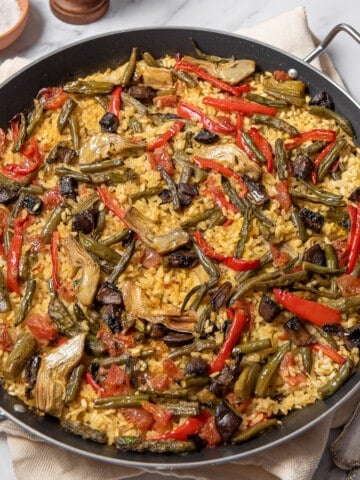
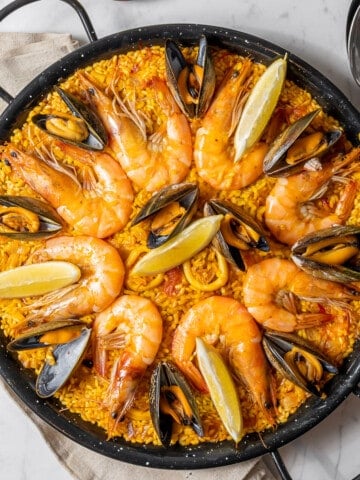
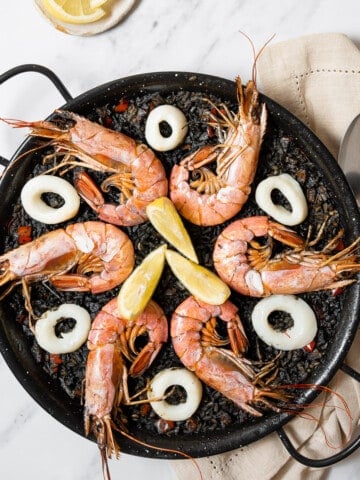
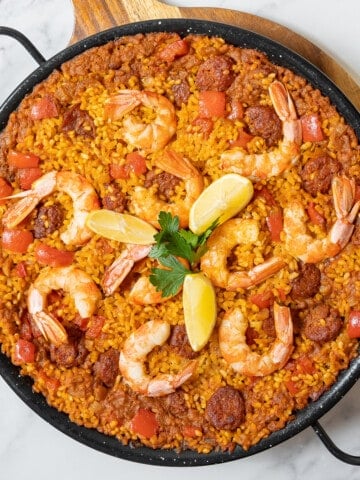
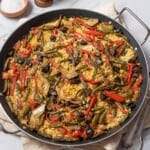
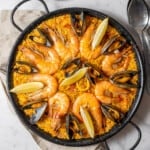
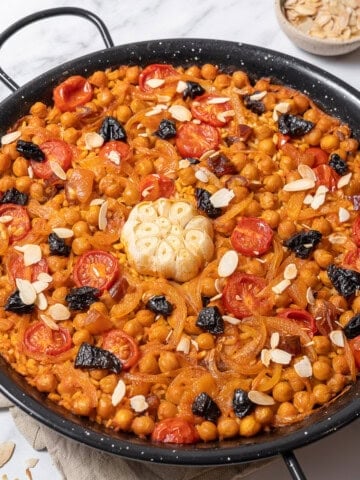
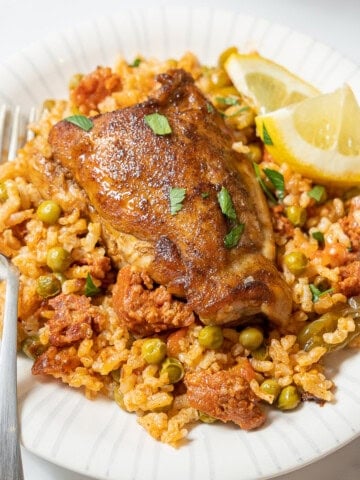

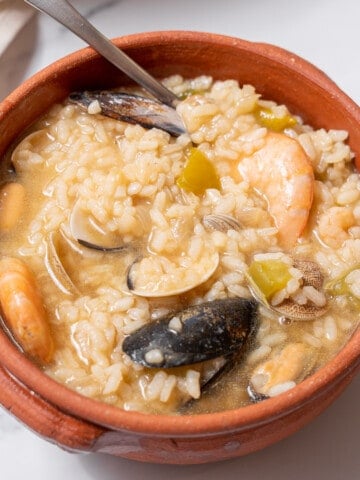
Techman90
This was my first time preparing this recipe and I am happy to say it was delicious. The flavors of the different spices were so well balanced. Unfortunately, I wasn’t able to get the rice to form the crust properly, but I will keep trying.
Thanks for a new recipe!
Dee
I made paella earlier this week per a request from hubby as he was thinking about our trip to Spain a year ago. I chose to use this recipe after comparisons to others. Hubby raved about how good it tasted and the aroma permeated the house and was mouthwatering.
Only changes I made was to use chicken tenders, diced cajun sausages and onions. I will definitely make this again!
Raul Torres
Delicious and easy to make
Grahame N
Don't forget the caracoles 🙂
Chris Nation
By the way, 'un/a socorrat/a', 'los socorratos' is the nickname for people from the town of Xativa, south of VLC city. In some 16C war of succession Xativa was on the losing side. The victors burned the town to cinders and derisively referred to the survivors as 'los socorratos'. Now the people of Xativa are proud of their nickname, of course - being one of the highlights of paella.
Xativa is home to another great Valenciano recipe - arroz al horno [baked rice]. Bomba rice, chunks of potato, tomatoes, chunks of park ribs, morcilla sausage, chicken legs/thighs ... The usual pre-cooking of the meaty stuff then all into a very large casserole and 40-60 mins in the oven.
Xativa has an annual competition for best arroz al horno.
Geoff Lawrence
I made this paella recently for a dinner party, and it was perfect. Though I've made paella a number of times in the past it involved considerably more steps cooking and removing ingredients, making quite a mess and taking more time. I used half a chicken and 1 1/2 pounds of ribs and the results from this recipe were great and I was fortunate to get the socarrat just right. I'll definitely make this more frequently!
Jeremy
Geoff - you mention following a Spanish recipe and being frustrated by having to remove ingredients in the process. In my early days living in Spain, when I spoke little of the language, I, too, was frustrated by having to 'remove' ingredients as I went along...until I learnt that 'remueve' meant 'stir', not remove!
Robin
I am really looking forward to making this recipe and cannot wait to share how delicious it was! My question...... I am hosting a paella party and need to serve 12- do I simply triple the ingredients or is there another way to go about this? I certainly don't want to ruin anything if I should adjust in another way then simply tripling. - thank you.
Robin
I think I may have answered my own question- when I went to print the recipe it let me change the servings and adjusted the ingredients! Thank you!
Lauren Aloise
Yes - the recipe plugin does this automatically, but it's not always accurate. 3x the quantities should do the trick - maybe go easy on the salt though. I haven't tried it myself, so let me know how it turns out!
Dale
Where’s the sprigs of rosemary? Having been born in Spain, traveled the country extensively, have eaten Valencia Paella, in the heart of the old city Valencia, the original, and its variants, all had several sprigs of rosemary. It truly adds to the authentic Valencia Paella experience. Oh and rabbit and chicken are a must, the snails can be optional. The original rustic VP always had snails.
John P Cosgrove
Sorry could not rate as I wanted ie 5 star. Tasty, easy to follow and, although I made my own modifications, tasted wonderful. The main addition was chorizo sausages. My pan was a little too small which made it a challenge. Highly recommended.
Chris Nation
If you admitted to adding chorizo to a Valenciano/a you would get a large paellera round your ears. Having visited VLC for 15 years and then lived there for 5, I can tell you they take the P. Valenciana very seriously. For example, when I told the guy on the rice stall in Mercado Central that I had bought lids for my various sizes of paelleras, he was horrified. Another customer there was similarly so. They gave me the tip which works if you have added too little water. You don't add water to the pan and put a lid on. You take 2-3 pages of the newspaper, wet them well and cover the pan. Amazingly, the rice draws the moisture from the paper and all is well! If you have put in too much water, you just gun the gas.
There is a great deal of very mediocre paella to be had in VLC. A good paella is not a cheap dish. For a start, saffron - the real thing - is key. It really makes a paella a paella but it is expensive stuff. My Valenciano house mate's mum sent me a jar of 'red powder', a colouring it seems most people use to make 'everyday' paella'. I was appalled!
Steve
Your response to Keith Rogers was, "I like my rice in a thin layer so I’d go for a 16 or 17 inch pan!" yet in the recipe you say a 22 inch pan. You say the ideal water/rice ratio is 2.5-3:1, yet you are using 5/9 of 1630ml, which is 900ml, to 400g of rice, i.e., well under the ideal ratios you quote. Please check these things before publishing a recipe that many might use.
Lauren Aloise
Hi there, thanks for the comments. The reply to Keith was for a previous version of the recipe (at the end the recipe states the updated date). And yes the water in ml was incorrect - I am not sure what I did but 9 cups is not 1630! It should be correct now. Thank you!!
Chris Nation
'A cup' is not a unit of measurement. 'Cups' come in a variety of sizes. There are units for measuring things. Apart from the USA [still Imperial] and UK [which is still dithering, presenting Imperial measurements alongside metric - after 30 years of C and F, the met temps are now centigrade only] the great majority of the world understands metric. Metric is universal - a bombproof expression of size/quantity. Nobody in Mercado Central in VLC would understand if you asked for X cups of lentils, for example.
Emma Dudley
This was a delicious Paella but have 2 suggestions: completely agree that 2 TBLS of salt would be totally insane. Although I do agree it is probably correct having been to Valencia and being completely unable to eat the paella I ordered as it was far, far too salty. (I would of been sick I think!) for anyone out of Spain I suggest the 2 teaspoons as everyone else has says. It will be inedible with more. And the way you have done the timings is weird? By "prep time" you actually mean the bulk of the cooking - the meat, tomato, water etc and "cooking time" you mean just the rice part. That's a strange way of describing it as "prep" is usually just cutting up your veg etc? This actually meant I was very, very late in serving my dinner (took about 2 hours from start to finish the rice took much longer and more water). I should of read the recipe through properly before planning ahead as then I would of seen that there is basically no prep other than grating a tomato! Now I know all this I will be making it again as it was delicious. You need a BIG pan for this. I had to use 2.
DH
I made this dish for the first time, and it was delicious! Even my critic foodie friends approved. I even got the socarrat on the first try . I think there was an error on the salt in the directions - it calls for 2 tablespoons, which is a lot. I used 2 teaspoons and it was just right
Lauren Aloise
Believe it or not, it is correct! It really brings out the flavors -- but yes, it is a lot of salt. Glad you enjoyed!
Chris Nation
A restaurant down on Malvarosa beach is rated as one of the best in VLC for paella and yet it has racked up consistent reviews that state that the amount of salt added made it inedible. As with most seasonings, adding to taste is the way to go. I'd guess that 2 tbls of salt would be fine in a paella for 20-25 people.
Valencian Guy
I would like to congratulate you and say thank you.
I'm tired of seeing around lots of dishes that they call paella and it's far away to be something similar. Using chorizo, peas, onions, you name it.
However in this case you have respected the basics of what a paella should be. It looks delicious and it can be what my mom used to do every Sunday at home.
Thanks for respecting a nice dish, besides it looks delicious.
Keith Rogers
Anyone know what size paella pan should be used for this recipe?
Lauren Aloise
I like my rice in a thin layer so I'd go for a 16 or 17 inch pan!
Jeneva Canlas Takasawa
My husband and I waited for a few days to taste Paella in Valencia. We
were told it was the best. I thought it was so-so but I got over it☺️. My first taste of paella was from my grandmother’s kitchen. She called it “ Bringhe”; the bottom was crispy rice and the body was not delicate but sticky. She threw in seafood- mussels, clams and shrimp. The adults loved scraping the bottom of the pan. You are spot on about the nature of the dish. It varies from cultural background and locality. My family is of South Asian, South American and Northern European descent. Our kitchen is representative of the heritage of several ethnicities in our blood.